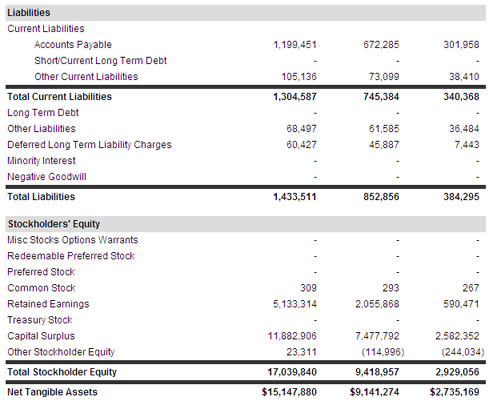
These financial statements are particularly significant for external stakeholders, such as investors, who rely on this information to make informed decisions about the company’s potential for growth and profitability. The analysis of annual financial statements can indicate trends, helping stakeholders project future performance and calculate the present value of potential investments. For small businesses with few income streams, you might generate single-step income statements on a regular basis and a multi-step income statement annually.
Income statement vs. balance sheet: what’s the difference?
Income statements can be complex, but understanding the different components is crucial to interpretation. This is because lenders want to know the ability of the company to generate revenue and profit, as well as its capacity to repay the loan. It includes marketing costs, rent, inventory costs, equipment, payroll, step costs, insurance, and funds intended for research and development. Operating expenses are the expenses the company incurs through its normal day-to-day operations. Direct costs can include parts, labor, materials, and other expenses directly related to production. It is also referred to as the cost of sales if the company is offering services.
- It provides insight into how much and how a business generates revenues, what the cost of doing business is, how efficiently it manages its cash, and what its assets and liabilities are.
- If the expenses are smaller than the sales, the net result is profitability, or net income, rather than a net loss.
- Ultimately, horizontal analysis is used to identify trends over time—comparisons from Q1 to Q2, for example—instead of revealing how individual line items relate to others.
- Financial statements are often audited by government agencies and accountants to ensure accuracy and for tax, financing, or investing purposes.
- They are mainly concerned with whether or not investing their money is the company with yield them a positive return.
Why is financial statement analysis important for investors and creditors?
The cash flow statement provides an overview of the company’s cash flows from operating activities, investing activities, and financing activities. Net income is carried over to the cash flow statement, where it is included as the top line item for operating activities. Like its title, investing activities include cash flows involved with firm-wide investments.
Interest expense
An income statement, also known as the trading and P&L account or revenue and expense summary, reveals the performance of your business entity within a specific accounting period. Now that we have a full income statement, we can look at another commonly used measure of financial performance called EBITDA. EBITDA stands for earnings before cash basis definition interest, taxes, depreciation, and amortization. It is the spreading of the cost of an intangible asset over the course of its useful life. Intangible assets are long-term assets that lack physical substance, such as patents and copyrights. Then remove the operating expenses mentioned and you get the company’s operating income.
What Is Financial Statement Analysis?
An income statement shows how effective the strategies set by the management at the beginning of an accounting period are. Another vital link between the two statements is the cost of goods sold (COGS) on the income statement. COGS represents the cost of producing or acquiring the goods sold by a company. If a company purchases inventory, the balance sheet will reflect the change in inventory value while the income statement recognises the change in COGS, affecting the net income. A higher operating income usually implies that the company has effective cost management while a higher net income indicates a better overall financial performance. Total revenue is a crucial figure for any business to consider, as it represents the total amount of money generated from the sale of goods or services.
How do financial statements reflect a company’s financial health and performance over a given period?

Other income could include gains from the sale of long-term assets such as land, vehicles, or a subsidiary. Dividends are payments made by a corporation to its shareholders, usually from its net profits. Retained earnings are the portion of net income that is retained by the company rather than being distributed as dividends. Comprehensive income encompasses all components of income and changes in equity other than transactions with stockholders, such as net income and other comprehensive income. Financial statements play a critical role in providing essential information to investors, creditors, and other stakeholders.
Some of these expenses may be written off on a tax return if they meet Internal Revenue Service (IRS) guidelines. Payment is usually accounted for in the period when sales are made or services are delivered. Receipts are the cash received and are accounted for when the money is received. Microsoft has a net income of $44.28 billion which is calculated by adding net other income to operating income or EBIT. This is calculated by deducting COGS worth $46.08 Billion from the Revenue of $143.02 billion.
Also, as you run through the adding and subtracting, you will improve your own understanding of exactly how the numbers fit together. No matter what twists and turns you take along the way, the last number on the income statement is crucial. Usually, the purpose of horizontal analysis is to detect growth trends across different time periods. Investing activities include any sources and uses of cash from a company’s investments in its long-term future. A purchase or sale of an asset, loans made to vendors or received from customers, or any payments related to a merger or acquisition are included in this category.
The purpose of a cash flow statement is to provide a detailed picture of what happened to a business’s cash during a specified duration of time, known as the accounting period. It demonstrates an organization’s ability to operate in the short and long term, based on how much cash is flowing into and out of it. When used in conjunction with the other financial statements, an income statement can give you a clear view of your cash flow.
Perhaps the most important of these accounting conventions refers to different methods of accounting. This method, as it affects the income statement, recognizes revenues when the sale of a product or service occurs and expenses when they are incurred. Where the income statement gets complicated is in understanding the assumptions underlying the seemingly simple line items.
For example annual statements use revenues and expenses over a 12-month period, while quarterly statements focus on revenues and expenses incurred during a 3-month period. An Income Statement is a financial statement that shows the revenues and expenses of a company over a specific accounting period. Depreciation is an accounting method that allows companies to allocate the cost of tangible assets, such as machinery, vehicles, and equipment, over their useful life.
Here’s an income statement we’ve created for a hypothetical small business—Coffee Roaster Enterprises Inc., a small hobbyist coffee roastery. Accurate records of expenses, revenues, and credits are required for tax purposes and can help keep you in compliance with tax regulations. Our mission is to empower readers with the most factual and reliable financial information possible to help them make informed decisions for their individual needs. It helps managers and business owners point out which company expenses are growing at an unexpected rate and which of these expenses need to be cut down in the future. It provides them with a summary of the performance of the company during a specific period. Income statements are generally used to serve as a reporting metric for various stakeholders.
Therefore, to prepare the income statement for your business, you need to report the revenues, expenses, and subsequent profits or losses within a specific accounting period. An income statement is one of your business’s most important financial statements and showcases the profit earned or losses incurred by your business during an accounting period. The income statement shows a firm’s performance over a specific period of time.
How about when the talk turns to income statements, or profit and loss reports, or even a “statement of activities”? The first bit of good news is that all of these refer to the same thing, so you may not have as much to learn as you thought. The second is that an income statement is based on a few very simple grants management process concepts, which you already understand. Non-operating expenses are costs that are not related to a company’s core operations. “Other income/expense” is often included in this section and can include changes in the value of assets the company owns (if it owns shares in another public business for example).
Several techniques are commonly used as part of financial statement analysis. Three of the most important techniques are horizontal analysis, vertical analysis, and ratio analysis. Horizontal analysis compares data calculate bad debt expense methods examples horizontally, by analyzing values of line items across two or more years. Vertical analysis looks at the vertical effects that line items have on other parts of the business and the business’s proportions.